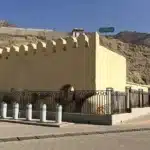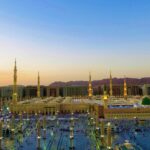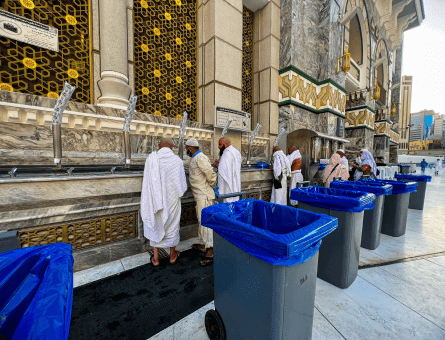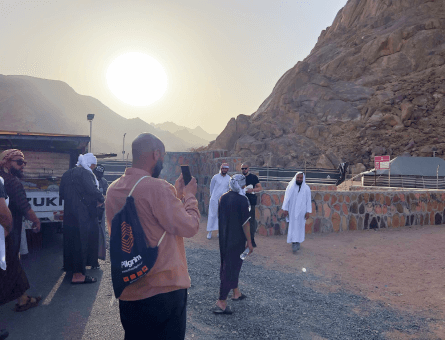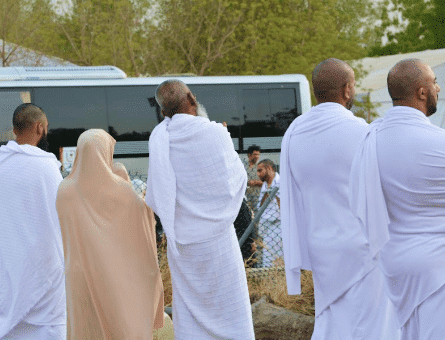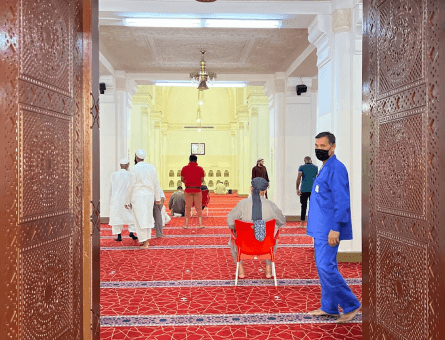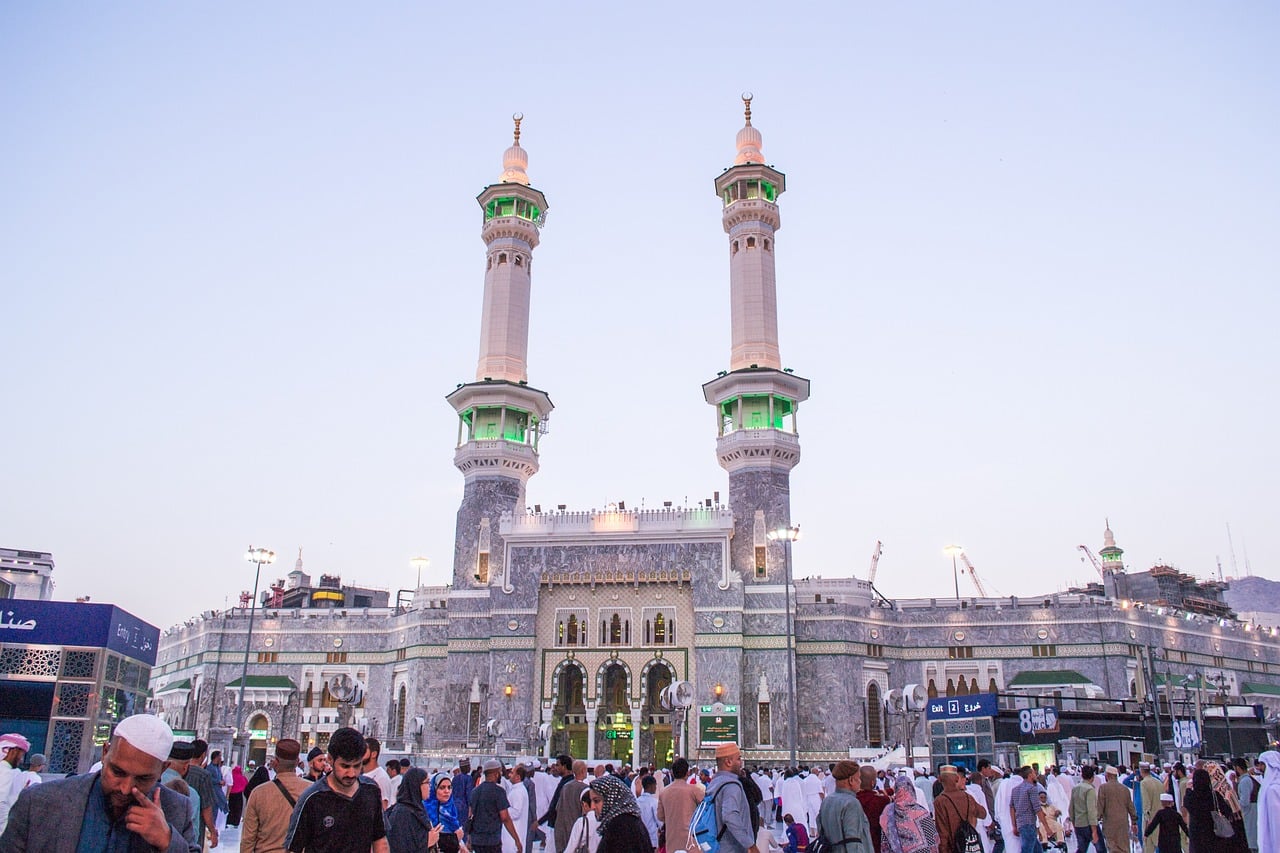Gates of Masjid Al Haram – Complete List of All Gates/Doors
Masjid Al Haram, situated in the heart of Mecca, stands as the epitome of sanctity and spiritual significance for Muslims globally.
Its name translates to “The Sacred Mosque,” and its importance is unparalleled, as it is not only a religious landmark but also a symbol of unity for the Islamic community.
Masjid Al Haram – Holiest Mosque in Islam
Masjid Al Haram is no ordinary mosque; it is the holiest sanctuary in Islam, housing the Kaaba, the sacred structure that Muslims worldwide face during their daily prayers.
Its roots trace back to the time of Prophet Ibrahim (AS) with his son Isma’il (AS), was instrumental in constructing the Kaaba as a house of worship dedicated to the monotheistic worship of Allah (SWT).
The holy mosque has undergone various expansions throughout history, with the current architectural masterpiece accommodating millions of worshippers during the annual Hajj pilgrimage.
Significance for Muslims Around the World
For Muslims, Masjid Al Haram is not just a physical space; it is a spiritual compass that unites the Ummah (Muslim community) in their devotion to Allah (SWT).
Pilgrimage to Mecca, particularly during Hajj, is one of the Five Pillars of Islam, emphasising the centrality of Masjid Al Haram in the life of every devout Muslim.
The magnetic pull of this holy site transcends geographical boundaries, drawing Muslims from diverse cultures, languages, and backgrounds to gather in prayer, fostering a profound sense of brotherhood and unity.
List of Gates of Masjid Al Haram
- King Abdul Aziz – Gate 1
- Bab e Ajyad – Gate 5
- Bab e Bilal – Gate 6
- Bab e Hunain – Gate 9
- Bab e Ismail – Gate 10
- Bab e Safa – Gate 11
- Bab Hamza – Gate 12
- Bab Qubais – Gate 13
- Bab e Nabi – Gate 14
- Bab e Nabi Bridge – Gate 15
- Bab Darul Arqam – Gate 16
- Bab e Ali – Gate 17
- Bab Abbas – Gate 20
- Bab e Bani Hasim – Gate 21
- Bab Bani Shaybah – Gate 22
- Bab al Marwah – Gate 23
- Bab Al Mudah – Gate 25
- Bab e Quraysh – Gate 26 to 27
- Bab al Arafah – Gate 35
- Bab e Muzdalifah – Gate 36
- Bab e Fatah – Gate 45
- Bab Omar Farooq – Gate 49
- Bab al Quds – Gate 55
- Bab e Madina – Gate 56
- Bab al Umrah – Gate 63
- Bab Ammar Bin Yasser – Gate 67
- Bab Moaz Bin Jabal – Gate 68
- Bab Amro Bin Al Aas – Gate 69
- Bab Aisha Bint Abu Bakr – Gate 70
- Bab Asma Bint Abu Bakr – Gate 71
- Bab Al Yarmouk – Gate 73
- Bab Abu Bakr – Gate 74
- Bab Al Fahad – Gate 79
- Bab Jabir Bin Abdullah – Gate 84
- Bab Saeed Bin Zaid – Gate 85
- Bab Umm Hani – Gate 87
- Bab e Maimoonah – Gate 88
- Bab Al Hijlah – Gate 89
- Bab Hafsa – Gate 90
- Bab khadijah – Gate 93
- Bab Ibrahim – Gate 94
- King Abdullah Gate – Gate 100
- Gate 166
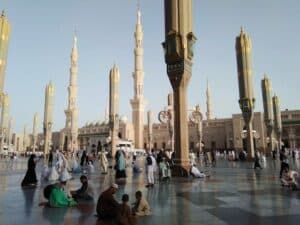
Masjid Al Haram – Architectural Marvel
In this exploration, our focus shifts towards the intricacies of Masjid Al Haram’s architectural marvel—the gates that stand as silent sentinels, witnessing the ebb and flow of worshippers.
These gates are not merely entrances; they are symbolic thresholds that carry historical narratives, cultural richness, and spiritual significance.
Each gate, with its unique characteristics and stories, contributes to the holistic experience of those who enter the sacred precincts of Masjid Al Haram.
Join us on this journey as we delve into the rich tapestry of the gates of Masjid Al Haram, unraveling the threads that connect the past, present, and future of this sacred space.
Historical Background – Constructing the Sacred Sanctuary
Construction of Masjid Al Haram: A Divine Blueprint
The genesis of Masjid Al Haram is deeply rooted in the narratives of Prophet Ibrahim (AS) and his son Isma’il (AS).
According to Islamic tradition, under divine guidance, they laid the foundations of the Kaaba, the sacred cubic structure at the core of Masjid Al Haram.
This construction, with its divine origin, serves as a testament to the unbreakable connection between the earthly realm and the divine, establishing the sanctity of the mosque.
Key Historical Events Shaping the Mosque’s Development
Over the centuries, Masjid Al Haram has evolved, witnessing transformative historical events that shaped its physical and spiritual dimensions.
Notable among these is the era of the Prophet Muhammad (SAW), who, after the conquest of Mecca in 630 CE, cleansed the Kaaba of idolatrous symbols, restoring it to its original monotheistic purpose.
Subsequent caliphs and rulers have contributed to the expansion and refurbishment of the mosque, each imprinting their mark on this spiritual nucleus.
The Ottoman era also played a pivotal role in the mosque’s development, with Sultan Selim II overseeing significant expansions in the 16th century.
The most recent expansion, spearheaded by the Kingdom of Saudi Arabia, reflects a commitment to accommodate the ever-growing number of pilgrims and enhance the overall experience of worshippers.
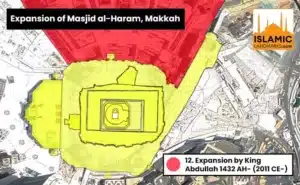
Cultural and Religious Importance of the Site
Masjid Al Haram is not merely a historical relic but a living testament to the cultural and religious tapestry of Islam.
The site encapsulates the diversity within the Islamic world, as millions of worshippers from various nations congregate in Mecca during Hajj and Umrah.
The cultural significance of Masjid Al Haram extends beyond religious practices; it serves as a symbol of unity, fostering a sense of belonging among Muslims worldwide.
The annual pilgrimage to Mecca, a fundamental tenet of Islam, draws the faithful to Masjid Al Haram, creating a spiritual bond that transcends geographical, linguistic, and cultural boundaries.
The mosque stands as a living embodiment of the shared heritage and devotion of the global Muslim community, reinforcing the enduring cultural and religious importance of this sacred site.
The Majestic Design of Masjid Al Haram
Overall Architectural Design
The architectural magnificence of Masjid Al Haram is a harmonious blend of tradition and modernity, a testament to the evolution of Islamic architecture over the centuries. The mosque’s expansive structure sprawls over a vast area, with towering minarets punctuating the skyline.
The central focal point is, undoubtedly, the Kaaba, the spiritual nucleus around which the entire architectural ensemble orbits.
The grandeur of Masjid Al Haram is not merely a visual spectacle but a manifestation of the profound spiritual significance that it holds for Muslims worldwide.
Significance of the Kaaba in the Mosque’s Layout
At the heart of Masjid Al Haram lies the Kaaba, a simple yet powerful structure draped in a black silk and gold curtain known as the Kiswah.
The architectural design revolves around the Kaaba, with the mosque’s axis aligned towards it.
Pilgrims, during their prayers, face the Kaaba, symbolising a symbolic unity in worship.
The Kaaba’s sacredness is reflected in its central location within the mosque, acting as a gravitational force that draws worshippers towards its sanctified presence.
The circumambulation, or Tawaf, wherein pilgrims walk around the Kaaba in a counterclockwise direction, is a ritual central to the Hajj and Umrah pilgrimages.
This ritual emphasises the spiritual and physical centrality of the Kaaba in the lives of Muslims, reinforcing a sense of unity and devotion.
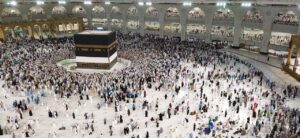
Role of the Gates in the Overall Design
The gates of Masjid Al Haram are not mere portals; they are integral elements of the mosque’s overall design, contributing to its functionality and symbolism.
These gates, strategically positioned around the perimeter, provide access to the sacred precincts, guiding the flow of worshippers and facilitating the rituals associated with the pilgrimage.
Each gate is a unique architectural element adorned with intricate designs and inscriptions that reflect the historical and cultural richness of Islamic civilization.
Beyond their practical function, the gates serve as symbolic thresholds, marking the transition from the mundane to the sacred.
As worshippers enter through these gates, they step into a realm of spiritual significance, leaving behind the worldly concerns outside.
The gates, through their design and positioning, contribute to the overall spiritual experience within Masjid Al Haram, creating a seamless connection between the physical architecture and the metaphysical realm of devotion.
Symbolic Importance of Gates in Islamic Architecture – Portals to the Sacred
Gates in Islamic architecture transcend their functional role as mere entry points; they are symbolic embodiments of transition, both physical and spiritual.
Rooted in the rich tradition of Islamic art and architecture, gates serve as architectural features that signify the threshold between the sacred and the profane.
Their designs often incorporate intricate geometric patterns, calligraphy, and ornate detailing, showcasing the cultural and artistic depth of Islamic civilisation.
Islamic architecture, in general, places a profound emphasis on symbolism, with each element reflecting spiritual meanings.
The gates of Masjid Al Haram are no exception, representing the symbolic gateways through which worshippers enter a space infused with divine presence.
The intricate embellishments on the gates narrate stories of faith, history, and reverence, creating a visual tapestry that enriches the spiritual experience of those who pass through them.
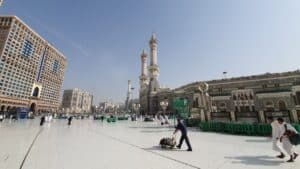
Spiritual Significance of Entering Through These Gates
Stepping through the gates of Masjid Al Haram is not a mundane act but a spiritual journey.
The transition from the bustling streets of Mecca to the sacred precincts within the mosque is a symbolic movement from the worldly to the divine.
Each gate marks a spiritual threshold, inviting worshippers to leave behind the concerns of daily life and enter a realm where the connection with the divine is paramount.
The act of passing through these gates is not merely a physical passage but a spiritual acknowledgment of entering a sacred space.
It is a moment of reflection, preparation, and submission as worshippers prepare to engage in acts of devotion, prayer, and contemplation.
The gates, adorned with Quranic verses and artistic expressions, guide individuals towards a state of mindfulness and spiritual awareness.
Unique Historical and Religious Context of Each Gate
The gates of Masjid Al Haram are not uniform; each possesses its unique historical and religious context, contributing to the diverse tapestry of Islamic heritage.
King Abdulaziz Gate
The King Abdulaziz Gate, named after the founder of modern Saudi Arabia, holds historical significance as a tribute to the leader who played a pivotal role in the expansion and modernisation of Masjid Al Haram.
It serves as a testament to the evolving relationship between the Saudi state and the sacred mosque, with the gate witnessing a multitude of historical events and ceremonies.
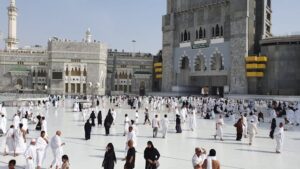
Ajyad Gate
The Ajyad Gate, located on the western side, holds historical importance as the entrance used by pilgrims traveling from the Ajyad area.
This gate has undergone multiple renovations, reflecting the commitment to preserving its historical character while adapting to the evolving needs of worshippers.
Ibrahim Gate
The Ibrahim Gate, situated near the Kaaba, is named after the Prophet Ibrahim (AS).
This gate holds spiritual significance as it is believed to be the point where prophet Ibrahim (AS) and prophet Isma’il (AS) entered the Kaaba to commence its construction.
Pilgrims often seek to enter through this gate, connecting with the historical roots of the mosque.
Other Gates
While specific gates may not be individually highlighted here, each gate around Masjid Al Haram contributes to the spiritual narrative in its unique way.
These gates, whether named or not, serve as conduits for millions of worshippers, carrying the weight of history and tradition.
Pilgrims entering through any gate participate in a timeless journey, traversing the same paths as countless believers before them.
Each gate, with its distinct architectural features and historical associations, adds layers to the rich tapestry of Masjid Al Haram, inviting worshippers to engage with the spiritual heritage embedded in the very foundations of the mosque.
They stand as witnesses to the unfolding history of Islam, inviting worshippers to partake in the timeless pilgrimage experience while honoring the legacy of those who came before.
Al-Safa and Al-Marwah Gates – Sanctified Gateways of Ritual and Resilience
Significance of the Al-Safa and Al-Marwah Gates
The Al-Safa and Al-Marwah Gates are portals steeped in spiritual significance, closely tied to the ancient ritual of Sa’i during the Hajj pilgrimage.
These gates mark the points of entry to the Safa and Marwah hills, two elevated locations integral to the Sa’i ritual.
Pilgrims embark on a symbolic journey, retracing the footsteps of Hagar, the wife of Prophet Ibrahim (AS), who ran between these hills in search of water for her son Isma’il (AS).
The gates serve as gateways to a ritual that encapsulates themes of faith, resilience, and divine providence.
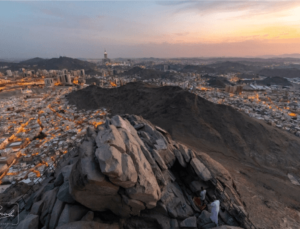
Historical Context of the Al-Safa and Al-Marwah Gates
The historical roots of these gates are intertwined with the narrative of Hagar and her son Isma’il (AS). The story recounts Hagar’s desperate search for water in the arid valley, a poignant testament to unwavering faith in divine sustenance.
It was during this search that the miracle of the well of Zamzam occurred, a symbol of God’s mercy in response to Hagar’s determination and trust.
The gates, therefore, stand as entry points to the sacred hills where this profound episode unfolded, immortalising the resilience of Hagar and the providential intervention that shaped the destiny of Mecca.
Rituals and Practices Associated with These Specific Gates
The Sa’i ritual, performed between Safa and Marwah, is a fundamental part of the Hajj pilgrimage and Umrah. Pilgrims proceed to the Safa gate to commence the Sa’i after completing the Tawaf around the Kaaba.
The ritual involves seven rounds of brisk walking and running between the hills, symbolising Hagar’s search for water.
Pilgrims begin at Safa and conclude at Marwah, completing the ritual with prayers and supplications.
The gates serve as points of entry and exit for pilgrims engaging in this ritual, guiding them through the spiritually charged journey.
The Sa’i embodies the themes of trust in divine providence and the endurance of faith, making the Al-Safa and Al-Marwah Gates not only physical thresholds but also symbolic portals to the spiritual resilience embedded in the pilgrimage experience.
King Abdulaziz Gate -Guardian of Legacy
History and Significance of the King Abdulaziz Gate
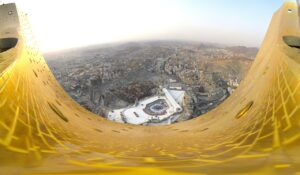
The King Abdulaziz Gate, named after the founder of modern Saudi Arabia, King Abdulaziz Al Saud, stands as a testament to the intersection of history, leadership, and devotion.
Commissioned during the reign of King Fahd in the 1980s, this gate holds deep significance as a symbol of the Kingdom’s commitment to preserving the sanctity of Masjid Al Haram.
It serves not only as an architectural marvel but also as a gateway through which millions enter to engage in acts of worship and spiritual reflection.
Renovations and Changes Over Time
Over the years, the King Abdulaziz Gate has undergone renovations to accommodate the growing number of pilgrims and enhance the overall experience of worshippers.
Renowned for its intricate calligraphy and traditional Islamic geometric patterns, the gate reflects a blend of contemporary design and timeless symbolism.
These renovations not only reinforce the gate’s structural integrity but also underline the Kingdom’s dedication to maintaining the spiritual and historical heritage of Masjid Al Haram.
Events and Ceremonies Associated with the Gate
The King Abdulaziz Gate has been the venue for numerous significant events and ceremonies. It has witnessed the arrival of dignitaries, heads of state, and leaders from the Muslim world during special occasions and religious events.
The gate plays a pivotal role during the annual Hajj pilgrimage, as it serves as one of the key entry points for the vast multitude of pilgrims who converge on Mecca.
Its significance is further emphasised during the circumambulation of the Kaaba, a ritual where pilgrims often commence their Tawaf from the vicinity of the King Abdulaziz Gate.
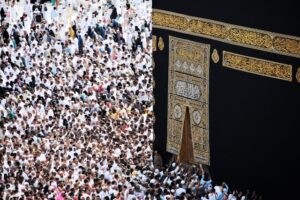
Other Major Gates – Gates of History and Heritage
Ajyad Gate and Ibrahim Gate
The Ajyad Gate, situated on the western side, and the Ibrahim Gate, located near the Kaaba, each have their unique historical and cultural context.
The Ajyad Gate historically served as an entry point for pilgrims arriving from the Ajyad area, preserving the historical connection of Mecca to its surrounding regions.
The Ibrahim Gate, named after the Prophet Ibrahim, holds spiritual significance as the believed entry point for Ibrahim and Isma’il during the construction of the Kaaba.
Pilgrims entering through these gates engage with the historical narrative of Masjid Al Haram, forging a connection with the foundational moments of Islam.
Historical and Cultural Context for Each Gate
The Ajyad and Ibrahim Gates, like all gates surrounding Masjid Al Haram, are steeped in history, reflecting the diverse cultural and religious heritage of Islam.
These gates have witnessed the ebb and flow of pilgrims, the architectural expansions of the mosque, and the enduring legacy of Islamic civilisation.
Unique Features and Symbolism
Each gate bears unique features and symbolism that contribute to the overall narrative of Masjid Al Haram.
From the calligraphy adorning the gates to the specific historical events associated with them, each gate adds layers to the spiritual journey of worshippers.
The Ajyad Gate, for example, symbolises the diverse origins of pilgrims, while the Ibrahim Gate echoes the footsteps of prophets in the sacred construction of the Kaaba.
In essence, the gates of Masjid Al Haram, whether named or not, collectively form a mosaic of history, spirituality, and cultural richness, inviting worshippers to explore the multifaceted tapestry of Islam’s holiest sanctuary.
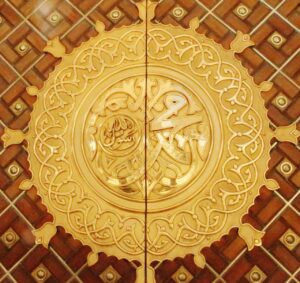
Modern Developments and Challenges – Evolution Amidst Tradition
Recent Developments and Renovations
In recent times, Masjid Al Haram has undergone significant developments and renovations, including those related to its gates. The expansion projects initiated by the Kingdom of Saudi Arabia have aimed at accommodating the ever-increasing number of worshippers.
While preserving the historical essence, these projects have incorporated modern architectural techniques and materials to ensure the structural integrity of the gates.
The King Abdulaziz Gate, for instance, has seen renovations that blend contemporary design with the rich historical tapestry of the mosque.
Challenges in Preserving Historical Integrity
Preserving the historical integrity of the gates presents a delicate balance between tradition and modernity.
The challenge lies in adapting the gates to meet the needs of a growing number of pilgrims while safeguarding their historical significance.
Striking this balance requires meticulous planning and execution to ensure that renovations do not compromise the cultural and spiritual essence encapsulated in each gate.
Preserving the gates as portals to history while embracing the demands of the present remains an ongoing challenge.
Role of Technology in Maintaining and Enhancing Gates
Technology plays a crucial role in the maintenance and enhancement of Masjid Al Haram’s gates. Surveillance systems, air conditioning, climate control technologies, and state-of-the-art materials contribute to the preservation of the gates.
Moreover, digital advancements aid in crowd management and security, ensuring the safety of worshippers during peak times.
Technology is not merely a tool for maintenance but a means of enhancing the overall experience.
It allows worshippers to engage with the gates through virtual platforms, fostering a global connection to the spiritual heart of Islam.

Gateways to the Divine: A Summation
The gates of Masjid Al Haram stand as more than physical entrances; they are conduits to the divine, steeped in history, symbolism, and spiritual significance.
From the ancient rituals performed between Al-Safa and Al-Marwah Gates to the contemporary renovations and challenges faced in preserving historical integrity, each gate contributes to the rich narrative of Islam’s holiest sanctuary.
Reiterating the Importance of Gates in Spiritual Experience
As worshippers enter through these gates, they embark on a spiritual journey, connecting with the past while participating in the present.
The gates serve as reminders of the diverse history, resilience, and unwavering faith embedded in the pilgrimage experience.
They are not mere structures but sacred portals facilitating a profound connection between the earthly and the divine.
Exploration and Appreciation
Readers are encouraged to explore and appreciate the rich history and symbolism behind each gate.
The gates of Masjid Al Haram are invitations to delve into the spiritual legacy of Islam, fostering a deeper understanding of the cultural and religious tapestry that has shaped this sacred space over centuries.
Summary – Gates of Masjid Al Haram
By embracing the significance of these gates, one can partake in a timeless journey that transcends the physical boundaries of Mecca, connecting hearts and souls in devotion and unity.
Through His Names
New course with
Ustadh Shabbir Hassan





